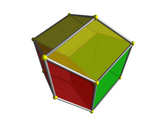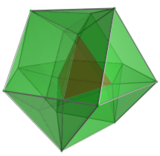User:Tetracube/Gallery of polychora
Welcome to the gallery of polychoron images!
This page is intended to collect images and animations of polychora to facilitate selecting the best ones for inclusion in the actual polychoron articles. The images will include vertex/edge/ridge/cell-first projections, with both perspective and parallel projections where the distinction matters, and possibly different combinations of enhancements applied to make the structure of the projection clearer.
Regular polychora
[edit]These are perspective projections of the regular polychora, scaled to an outradius of 1, and viewed 5 units away in 4-space. Note that all surfaces hidden from the 4D viewpoint (the facets on the far side of the polychoron) have been culled, for clarity.
| Polychoron | Vertex-first | Edge-first | Face-first | Cell-first |
|---|---|---|---|---|
| Pentachoron (5-cell) |

|

|

|

|
| 16-cell | 
|

|

|

|
| Tesseract (8-cell) |

|

|

|

|
| 24-cell | 
|

|

|

|
| 120-cell | 
|

|

|

|
| 600-cell | 
|

|

|

|
The following enhancements have been applied to these images:
- In vertex-first projections, the closest vertex is rendered as a small sphere in order to show its position within the projection image;
- In edge-first projections, the closest edge is rendered as a thin cylinder;
- In face-first projections, the closest face is highlighted;
- In cell-first projections, the closest cell is highlighted, except where it fills up the entirety of the image.
Further enhanced images
[edit]Below are some further-enhanced images, to accentuate parts of the structure of the projections:
| Polychoron | Image | Description |
|---|---|---|
| Tesseract | 
|
Vertex-first perspective projection with different-colored cells. Edges and vertices rendered as well. |

|
Edge-first projection of the same. | |

|
Face-first projection of the same. | |

|
Cell-first projection of the same. | |
| 24-cell | 
|
Cell-first perspective projection; cells around nearest cell in edge-outline. |

|
Same as above, with 4 more cells rendered in green. | |

|
Now with all cells. | |
| 120-cell | 
|
Vertex-first perspective projection; cells around the nearest vertex outlined. |
| File:120cell-perspective-cell-first-multilayer-01.png | Cell-first perspective projection; cells shown in 3 layers: nearest cell in solid color, 12 surrounding cells in transparent yellow, other cells directly connecting to these in edge-outline. The remaining cells are hidden from the 4D viewpoint, and are culled. | |
| 600-cell | 
|
Vertex-first perspective projection; the 20 cells surrounding the nearest vertex rendered in solid color (their icosahedral arrangement is clearly shown), cells immediately adjoining these rendered in transparent yellow, and remaining cells in edge outlines. Back-faces culled for clarity's sake. |

|
Cell-first perspective projection; nearest cell rendered in solid color, and cells sharing at least 1 vertex with this cell rendered in transparent yellow. Remaining cells in edge-outline. Back-faces culled for clarity. This particular viewpoint shows a nice outline of 5 tetrahedra sharing an edge, in front of the yellow cell complex. |
Uniform polychora
[edit]Uniform polychora images are grouped based on the positions of the elements of their base polychoron (taken to be the closest regular polychoron from which they are derived). For example, the base polychoron of the truncated 16-cell is the 16-cell, and the projection centered on a truncated tetrahedral cell is grouped under "base cell", and the projection centered on an octahedral cell is grouped under "base vertex". For the 5-cell and 24-cell groups, two of these elements are redundant because the base polychoron is self-dual.
5-cell group
[edit]| Polychoron | Base vertex | Base edge | Base face | Base cell |
|---|---|---|---|---|
| Rectified 5-cell | 
|
16-cell/tesseract group
[edit]| Polychoron | Base vertex | Base edge | Base face | Base cell |
|---|---|---|---|---|
| Truncated 16-cell |  (parallel) |
 (parallel) | ||
| Omnitruncated 8-cell |  (perspective) |
 (perspective) |
24-cell group
[edit]| Polychoron | Base vertex | Base edge | Base face | Base cell |
|---|---|---|---|---|
| Bitruncated 24-cell |  (perspective) |
N/A | N/A | |
| Runcinated 24-cell |  (perspective) |
|||
| Snub 24-cell |       
|
|||
| Omnitruncated 24-cell | 
|
N/A | N/A |
120-cell/600-cell group
[edit]Prismatic polychora
[edit]Polyhedral prisms
[edit]Duoprisms
[edit]Non-uniform Polychora
[edit]Cupolas
[edit]| Polychoron | Image | Description |
|---|---|---|
| Tetrahedral cupola | 
|
Perspective tetrahedron-first projection of the tetrahedral cupola. Nearest tetrahedron highlighted. Should be pretty close to the Schlegel diagram. |
| Cubic cupola | 
|
Perspective cube-first projection of the cubic cupola. Nearest cube highlighted. Viewpoint is looking from <0,0,0,-5>. This should be pretty close to the Schlegel diagram. |

|
Side-view, from <4,0,0,-1>. Here we see the cube foreshortened into a flattened cuboid, and the rhombicubotahedron (in blue) foreshortened as well (it is actually not an octahedral prism as it may appear; the 3D viewpoint doesn't show its cupola bottom). | |
| Octahedral cupola | 
|
Perspective octahedron-first projection of the octahedral cupola. Nearest cell highlighted. Viewpoint is looking from <0,0,0,-5>. This also should be pretty close to the Schlegel diagram. You can see the square pyramids and triangular prisms joining the cuboctohedral cell's square faces to the vertices and edges of the top octahedron, respectively. |

|
Side-view of the same. This time the viewpoint is level with the bottom cell, so it appears completely flattened. The top cell is almost completely flattened as well. The nearest square pyramid is shown in yellow. Hidden cells are culled for clarity. |
Rotatopes
[edit]Various curved 4D objects.
